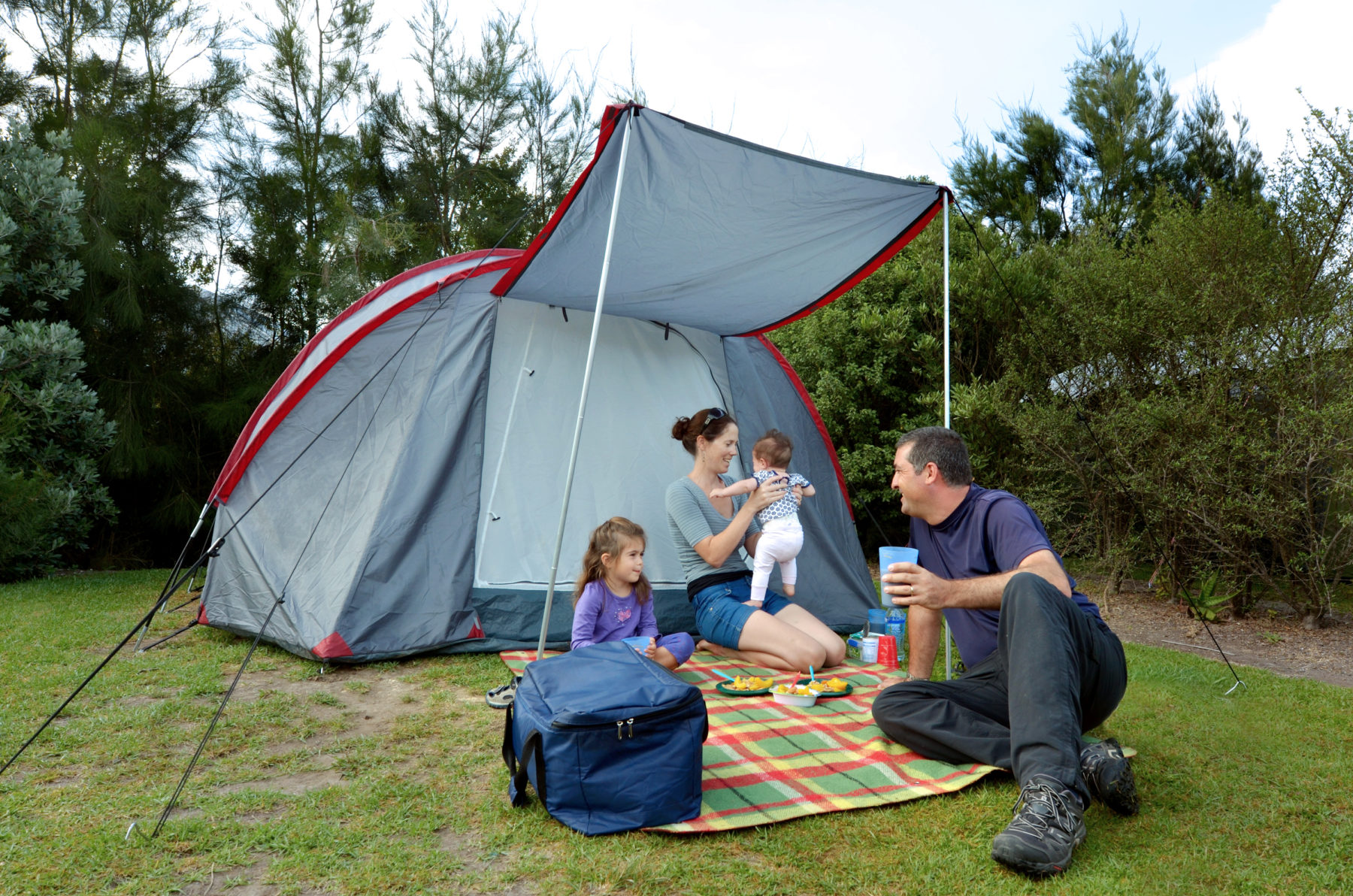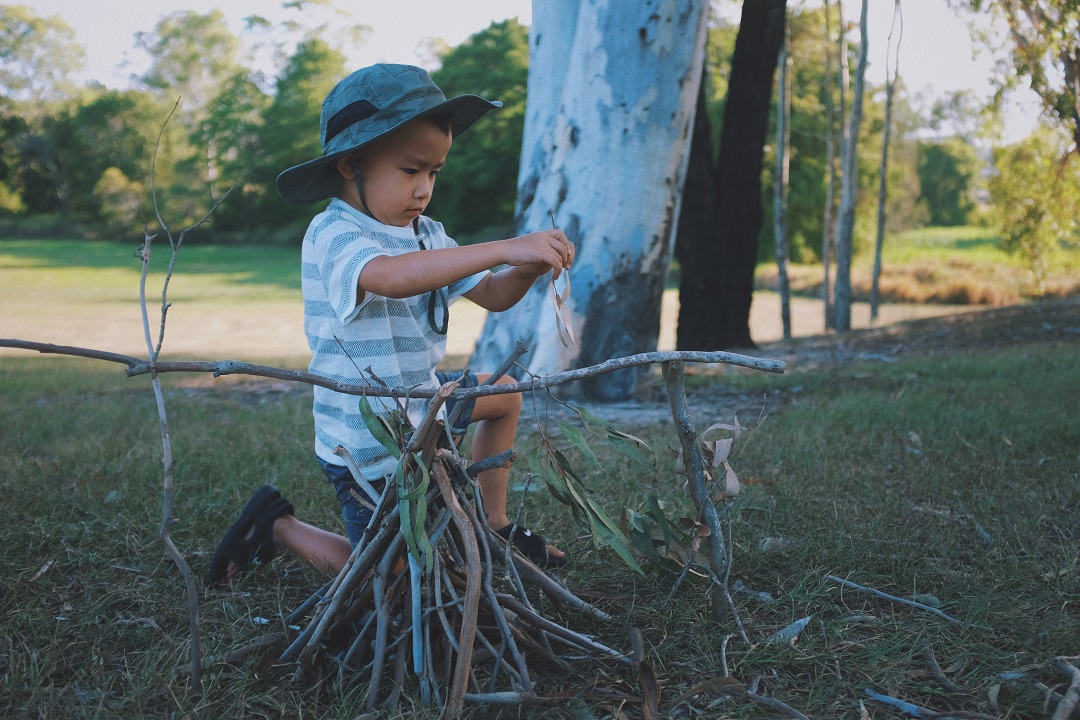Camping with babies or young children is not only possible, it can also be a lot of fun! It may feel overwhelming taking your kiddos for a night under the stars, but with a little careful planning, you’ll make amazing memories and inspire a lifetime love of the great outdoors. Here are some ways to make the experience easier and more fun for everyone involved.
Replicate the at-home sleeping environment. To avoid staying up all night with the nocturnal creatures, recreate your kid’s normal sleeping environment. If they’ve graduated to a bed, bring a sleeping pad. If they’re still snoozing in a crib, pack a bassinet, travel bed or play yard. If you use white noise, consider bringing a battery-operated sound machine. You’ll also want to keep your usual bedtime routine, so bring a book, stuffed animal, or any other trusty sleep aids. Finally, a headlamp is a must for middle of the night feeds, diaper changes, or potty runs.
Research the weather conditions and pack accordingly. Weather can be one of the biggest safety concerns when camping with babies and young kids. Research what to expect ahead of time and pack different layering options, so you can easily adjust as the temperature fluctuates or if any surprises occur. For cool- or wet-weather camping, synthetic or wool fabrics are ideal, as they provide reliable insulation and dry quickly.
For babies in cooler weather, a good rule of thumb is to dress them in one layer more than what you’re wearing. Remember, though, that babies can easily overheat. So, if you’re anticipating a chilly night, don’t just mindlessly add layers. Think through how the low temps compare to how you keep your house and go from there.
Bring protection from the sun… Too much sun exposure can not only cause harmful sunburns but also makes for an uncomfortable and cranky kiddo. Bring a hat, sunglasses, and child-safe sunscreen — according to the American Academy of Dermatology, kids should wear a sunscreen of at least 30 SPF. For babies younger than 6 months, ask your pediatrician, as even infant-specific sunscreen is typically not advised before then. Clothing, an umbrella, and a shady campsite can provide extra protection.
…and the bugs. It’s not exactly news that bugs cause itchy welts and disease. Pack a tick removal tool, and if your little ones are older than 6 months, bring along insect repellent. For younger babies, check with your pediatrician. (There are differing guidelines on what point repellent is safe; the Center for Disease Control says 2 months, while the Environmental Working Groups says 6 months.) The type of repellent you use is important, too. According to the American Academy of Pediatrics, you’ll want to go with an option with no more than 30-percent DEET or one with picaridin as the primary active ingredient.
To limit or avoid repellent altogether, consider packing citronella candles and long sleeves and pants with breathable fabric. Some play yards and playpens offer a netted cover — a great option for infants.

Instilling a love of nature is a priceless gift.
Know what to expect at the campsite. Some campsites offer amenities such as water and bathrooms, while others are bare bones. Know what to expect ahead of time, so if necessary you can bring water, toilet paper, and other must-have items. Be sure to check into the trash situation. If the site doesn’t offer a dumpster or trash cans, you’ll need to come prepared with trash bags (and a plan for how to stow dirty diapers until you leave).
Inspect your campsite for potential hazards. Before pitching your tent and making yourself at home, take a careful look around your campsite. Remove any debris and sharp sticks or rocks, and be sure there’s no lurking patch of poison ivy or other hazardous plants. Consider bringing along a large beach towel mat to give crawlers space to safely roam. A large tarp covered with a blanket also works well.
Have a plan for fire safety. Camping provides an opportunity to begin teaching youngsters about fire safety. For mobile little ones, take a few minutes to explain some rules, such as how close they’re allowed to get to the fire. If age-appropriate, consider letting them help with some carefully supervised campfire cooking — they’ll feel included and fire won’t be a tempting “forbidden fruit.” Infants and toddlers can also be plopped into a play yard to keep them safe while you’re building and enjoying the fire.
Come prepared for fun. Although it’s OK to bring a few toys from home, think through how the camp setting can keep kiddos entertained. You’re there to enjoy nature, so make the most of it. If there’s a beach, pack water and sand toys. For hiking, bring along a child carrier backpack if the terrain is too tough or the trail too long for little legs. If you’re planning on fishing or other activities that are difficult for very young children to participate in, use something to safely contain them, such as a portable play yard.
Whether your first family camping trip is in your own backyard or roughing it, planning ahead is essential to ensure everyone has an enjoyable, safe time. Instilling a love for nature is a priceless gift to give your little ones, just remember to relax and be flexible during your outdoor adventures — it may not go perfectly (what does when there’s kids involved?), but you can still have tons of fun!
Author: Stephanie Zeilenga is a regular contributor to Terrain Magazine.


Leave A Comment